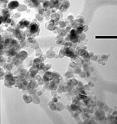New device better traps viruses, airborne pathogens
Washington University engineering researchers have created a new type of air-cleaning technology that could better protect human lungs from allergens, airborne viruses and ultrafine particles in the air. The device, known as the SXC ESP, was created by a team led by Pratim Biswas, PhD, the Lucy & Stanley Lopata Professor and chair of the Department of Energy, Environmental & Chemical Engineering in the School of Engineering & Applied Science.
A recent study of the device, published in Applied and Environmental Microbiology, found that it could help to prevent respiratory and viral infections and inhalation-induced allergic reactions more efficiently than existing filter-based systems.
Asthma, a chronic respiratory disease that can be triggered by inhaling allergens, pollen, pet dander and other particles, is one of the most costly health-care expenses in the United States at more than $50 billion.
"Because many people in developed countries spend the majority of time indoors, properly maintaining indoor air quality is an absolute necessity to protect public health," Biswas says.
The new device incorporates soft X-ray irradiation as a component of the electrostatic precipitation process currently used to remove large particles from airflows. By incorporating the soft X-ray enhanced electrostatic precipitation technology, the researchers were able to ensure very efficient charging of the particles over a broad range of sizes and their capture in the SXC ESP.
They exposed mice with compromised immune systems to the downstream air stream passing through the unit that contacted infectious viruses, allergens, anthrax, smallpox and other particles in the air. The sensitive mice survived, indicating that the SXC ESP was very effective in removing these biological agents from the air.
"Traditional air cleaners can trap viruses or other toxic particles in the filter, where they linger and grow," Biswas says. "This device finds the virus or toxic particle or bioterror agent and inactivates it in one application."
Ultimately, this technology could be incorporated into stand-alone air cleaners or scaled for use in aircraft cabins, offices and residential HVAC systems. It also could be used to clean up a diesel engine or power plant exhaust.
Michael Gidding, who is expected to graduate in 2013 with an MBA, a bachelor's in chemical engineering and a master's in energy, environmental and chemical engineering, and Daniel Garcia, a May 2012 chemical engineering graduate, have teamed up to scale up this technology for commercial use. Their startup, Aerosol Control Technologies (ACT), is based on the patented process Biswas developed.
There are many applications for the technology in the coal industry, Gidding says, from dust control and safety at the mine to flue-gas treatment at the power plant.
Funding for this research was provided by the National Institutes of Health (NIH U54 AI05716003) to the Midwest Regional Center of Excellence for Biodefense and Emerging Infectious Disease Research and Saint Louis University startup funds.
